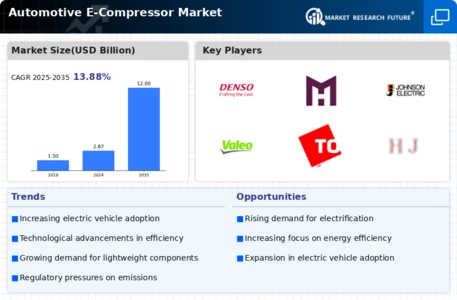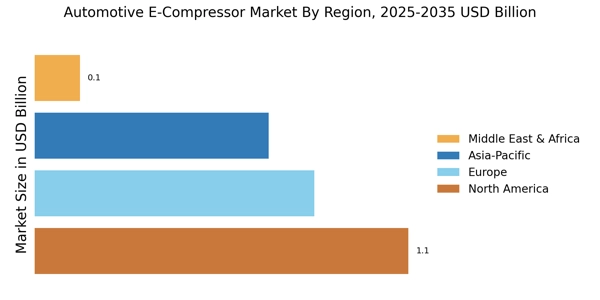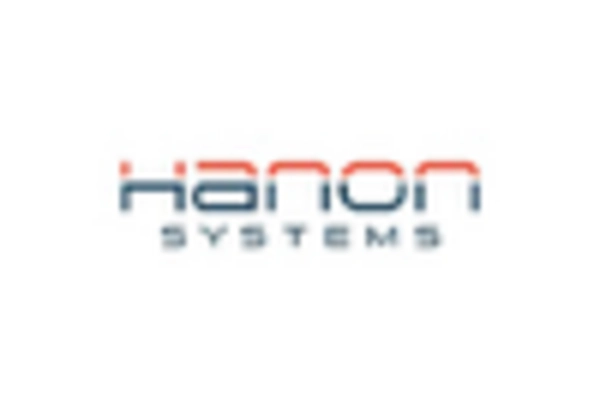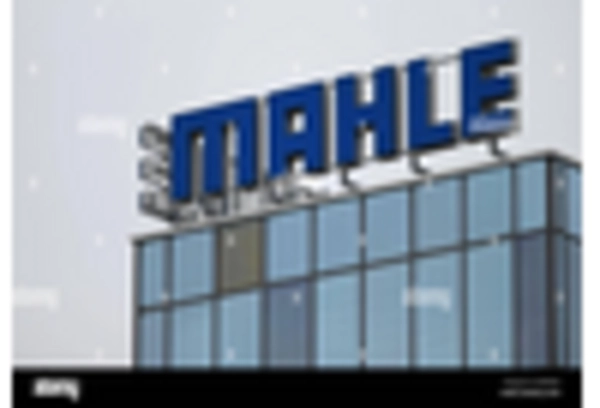Expansion of Hybrid Vehicle Segment
The expansion of the hybrid vehicle segment is another key driver for the Automotive E-Compressor Market. Hybrid vehicles, which combine internal combustion engines with electric propulsion, require sophisticated thermal management systems to optimize performance and efficiency. E-compressors are integral to these systems, providing the necessary cooling for both the electric and combustion components. As the hybrid vehicle market continues to grow, driven by consumer demand for fuel-efficient options, the Automotive E-Compressor Market is likely to see increased demand for e-compressors tailored to hybrid applications. This trend indicates a promising future for manufacturers who can adapt their offerings to meet the unique requirements of hybrid vehicles.
Regulatory Push for Emission Reductions
The Automotive E-Compressor Market is also influenced by regulatory frameworks aimed at reducing emissions and promoting energy efficiency. Governments worldwide are implementing stringent regulations that encourage the adoption of cleaner technologies in the automotive sector. This regulatory push is particularly relevant for electric vehicles, which require efficient thermal management systems to optimize performance. As a result, the demand for e-compressors is likely to increase, as they are essential for maintaining optimal operating temperatures in electric drivetrains. The Automotive E-Compressor Market stands to benefit from these regulations, as manufacturers align their product offerings with compliance requirements, thereby enhancing their market position and driving innovation.
Increasing Adoption of Electric Vehicles
The Automotive E-Compressor Market is experiencing a notable surge due to the increasing adoption of electric vehicles (EVs). As consumers and manufacturers alike shift towards more sustainable transportation options, the demand for efficient cooling systems in EVs has escalated. E-compressors play a crucial role in enhancing the performance of electric drivetrains by providing effective thermal management. According to recent data, the EV market is projected to grow at a compound annual growth rate (CAGR) of over 20% in the coming years, which directly influences the Automotive E-Compressor Market. This trend indicates a robust opportunity for manufacturers to innovate and cater to the specific needs of electric vehicle platforms, thereby driving growth in the e-compressor segment.
Growing Consumer Awareness of Sustainability
Consumer awareness regarding sustainability is a driving force in the Automotive E-Compressor Market. As individuals become more conscious of their environmental impact, there is a growing preference for vehicles that utilize energy-efficient technologies. This shift in consumer behavior is prompting automakers to invest in e-compressor technologies that align with sustainable practices. The demand for e-compressors is expected to rise as consumers increasingly seek vehicles that not only perform well but also contribute to lower carbon footprints. This trend suggests that the Automotive E-Compressor Market will continue to expand, as manufacturers respond to consumer preferences by developing innovative and eco-friendly e-compressor solutions.
Technological Advancements in E-Compressor Design
Technological advancements are significantly shaping the Automotive E-Compressor Market. Innovations in compressor design, such as the integration of variable speed drives and advanced materials, are enhancing the efficiency and performance of e-compressors. These advancements not only improve energy consumption but also reduce the overall weight of the systems, which is critical for electric vehicles. The market is witnessing a shift towards more compact and lightweight e-compressors, which can lead to improved vehicle range and performance. As manufacturers invest in research and development, the introduction of next-generation e-compressors is expected to further stimulate growth in the Automotive E-Compressor Market, potentially leading to a market size exceeding several billion dollars by the end of the decade.


















Leave a Comment